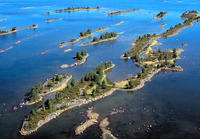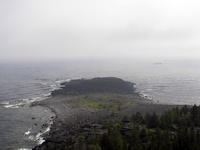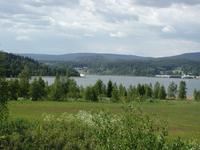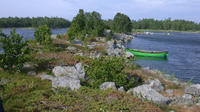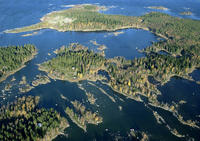| Site number: | 898 |
|
| Type of site: | Natural | |
| Date of Inscription: | 2000, 2006 | |
| Location: | Europe, Finland and Sweden, Gulf of Bothnia | |
| Description: | Found on Gulf of Bothnia’s west shore, the High Coast is a northern extension of the Baltic Sea. Covering 142,500 ha, the area embraces an 80,000 ha marine section, within which lie a number of offshore islands. The region with its irregular topography (made up of a series of lakes, inlets and flat hills rising to 350 m) has mainly been created by a combination of processes: glaciation, glacial retreat and new land surfacing from the sea. Ever since the last retreat of High Coast ice 9,600 years ago, the uplift has subsisted in the order of 285 m, which makes it the highest known 'rebound'. The High Coast site provides evidence for the understanding of important formation processes that shaped the Earth's glaciated land uplift areas. --WHMNet paraphrase from the description at WHC Site, where additional information is available. | |
| The High Coast (Swedish: Höga kusten) is a part of the Swedish coast on the Gulf of Bothnia, situated in the municipalities of Kramfors, Härnösand and Örnsköldsvik and notable as the "type area" for research on isostasy, in which the land rises as the weight of the glaciers melts off of it. This phenomenon was first recognised and studied there; since the last ice age the land has risen 800 m, which accounds for the unusual landscape with tall cliff formations. UNESCO, while inscribing the area on the World Heritage List in 2000, remarked that "the High Coast site affords outstanding opportunities for the understanding of the important processes that formed the glaciated and land uplift areas of the Earth's surface.
Kvarken (alternative spelling Quarken, Swedish Kvarken, Finnish Merenkurkku, or North Kvarken as opposed to South Kvarken) is the narrow region in the Gulf of Bothnia separating the Bothnian Bay (the inner part of the gulf) from the Bothnian Sea. The distance from Swedish mainland to Finnish mainland is around 80 km while the distance between the outmost islands is only 25 km. The water depth in the Kvarken region is only around 25 meters. The region also has an unusual rate of land rising at about 1 cm a year. On the Finnish side of Kvarken, there is a large archipelago. Most of the small islands are inhabited. The archipelago is smaller on the Swedish side of the region, and the islands have much steeper shores. The Kvarken region was historically important also, because mail was delivered across Kvarken when the sea was completely frozen from the Swedish to the Finnish coast. This mail route was used frequently during the period of Swedish rule. In 2006, the Kvarken Archipelago was added as an extension to the World Heritage Site of the High Coast (located on the western shore of the Gulf of Bothnia) in Sweden, because it is "continuously rising from the sea in a process of rapid glacio-isostatic uplift, whereby the land, previously weighed down under the weight of a glacier, lifts at rates that are among the highest in the world. As a consequence of the advancing shoreline, islands appear and unite, peninsulas expand, lakes evolve from bays and develop into marshes and peat fens. This property is essentially a "type area" for research on isostasy; the phenomenon having been first recognized and studied here." Most of the World Heritage Site is situated in the Korsholm municipality. --Wikipedia. Text is available under the Creative Commons Attribution-ShareAlike License. |
||
| Source: | http://whc.unesco.org/en/list/898 | |
| Reference: | 1. UNESCO World Heritage Center, Site Page. | |



